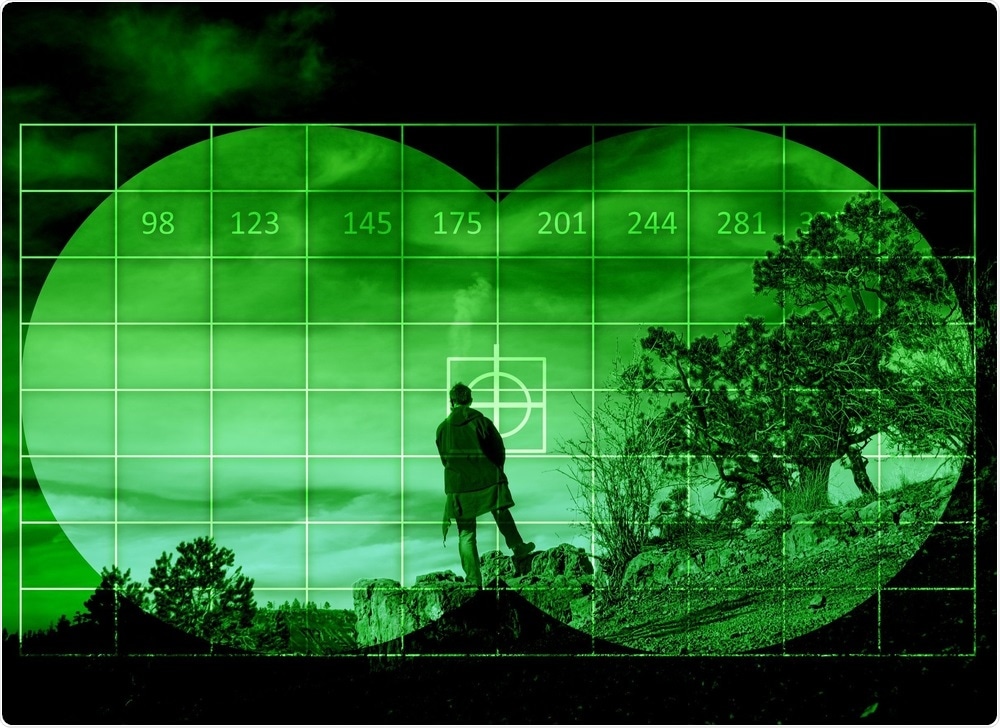Scientists have used nanoparticles to develop the ability to see near-infrared light in mice. The study could have important implications for security, health, and a never-before-seen enhancement to human vision.

Raimundo79 | Shutterstock
Gang Han, PhD, the lead researcher on the project, presented the results of this research at the American Chemical Society (ACS) Fall 2019 National Meeting & Exposition.
When we look at the universe, we see only visible light. But, if we had near-infrared vision, we could see the universe in a whole new way. We might be able to do infrared astronomy with the naked eye, or have night vision without bulky equipment.”
Gang Han, PhD
The human eye (along with other mammals) can see light between the wavelengths of 400 and 700 nanometers (nm), but near-infrared (NIR) light has wavelengths between 750 nm to 1.4 micrometers. As a result, we cannot see NIR light without special equipment to help us do so.
Thermal imaging cameras enable humans to see in the dark by picking up the near-infrared radiation emitted by other organisms or certain objects. To see whether this ability to pick up on near-infrared light could extend to mammals, Han and his colleagues injected a type of nanomaterial, called upconversion nanoparticles (UCNPs) into the eyes of mice.
UCNPs contain elements erbium and ytterbium, which are rare on Earth. Both elements are able to change low-energy photons from near-infrared light to higher-energy green light that sits in the band of wavelengths that human eyes can pick up on.
UCNPs are used to detect intracellular temperature differences and in drug delivery systems. In one method of UCNP drug delivery, UCNPs can bind the drug to a particle’s surface and release it into the body after a change in pH balance occurs.
 Organic nanoparticles in a vial convert invisible near-infrared light to intense blue light, which can easily be seen by human eyes. (Credit: Gang Han)
Organic nanoparticles in a vial convert invisible near-infrared light to intense blue light, which can easily be seen by human eyes. (Credit: Gang Han)
Developing night vision in mice
The University of Massachusetts Medical School researchers attached a protein that bound to a sugar molecule on the surface of photoreceptors in mice eyes in order to attract the UCNPs to the same area. The photoreceptors, having been bound to the UCNPs, were then injected behind the retinas of the mice’s retinas.
To assess the effects of these nanoparticle injections, Han and colleagues devised a series of physiological and behavioral tests. One of these tests included the mice being placed into a Y-shaped water tank, with one branch of the tank sporting a platform to help the mice escape the water.
The mice were trained to swim towards a triangle illuminated with visible light in order to find the escape platform. A circle was also illuminated in the branch of the tank that did not have an escape platform.
After the mice had been trained to head towards the triangle to escape, the researchers replaced the visible light triangle with a triangle illuminated with near-infrared light. Han spoke on the results of these experiments.
The mice with the particle injection could see the triangle clearly and swim to it each time, but the mice without the injection could not see or tell the difference between the two shapes.”
Gang Han, PhD
Assessing the safety of the technology
The researchers did not observe any adverse effects after the nanoparticle injections, but Han aims to improve the safety and sensitivity of the nanoparticles before any human tests take place. The UCNPs remained present in the mice’s eyes for around 10 weeks.
“The UCNPs in our published paper are inorganic, and there are some drawbacks there,” Han explained.
“The biocompatibility is not completely clear, and we need to improve the brightness of the nanoparticles for human use. We’ve shown that we can make organic UCNPs with much-improved brightness compared with the inorganic ones,” he concluded.
The team has already started experiments with UCNPs comprising two organic dyes instead of the earth-rare elements ytterbium and erbium.
Another advantage of using organic materials to make UCNPs would be the lighter regulations surrounding their use and the fact that the nanoparticles could also emit green or blue light.
The future of the research includes testing the effects of NIR light injections on dogs.
If we had a super dog that could see NIR light, we could project a pattern onto a lawbreaker’s body from a distance, and the dog could catch them without disturbing other people.”
However, it is in drug delivery that the research team believe the technology could be used to improve disease outcomes in eye health.
Han said the team are currently “looking at how to use NIR light to release a drug from the UNCPs specifically at the photoreceptors.”
UMMS scientists develop technology to give night vision to mammals
Journal reference:
Chen, G., et al. (2019). Upconversion Nanoparticles: Design, Nanochemistry, and Applications in Theranostics. American Chemical Society. https://pubs.acs.org/doi/10.1021/cr400425h